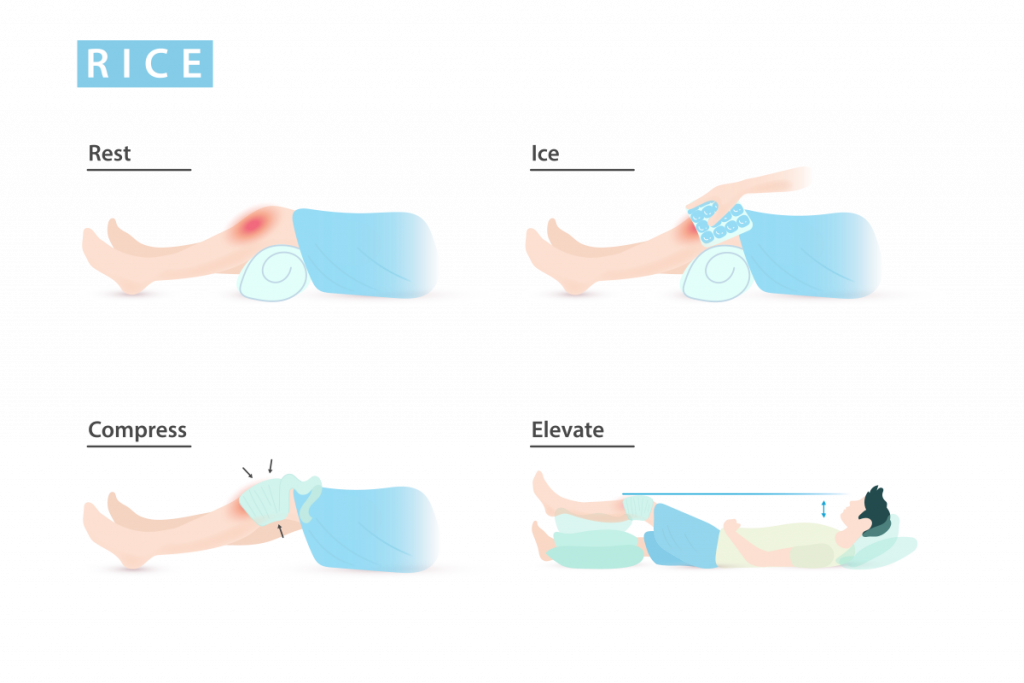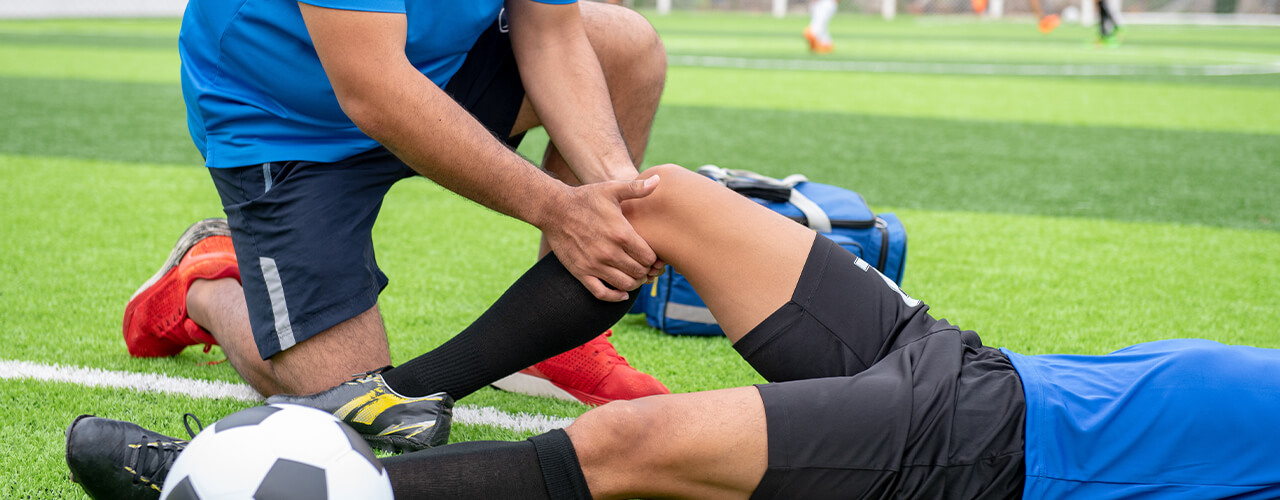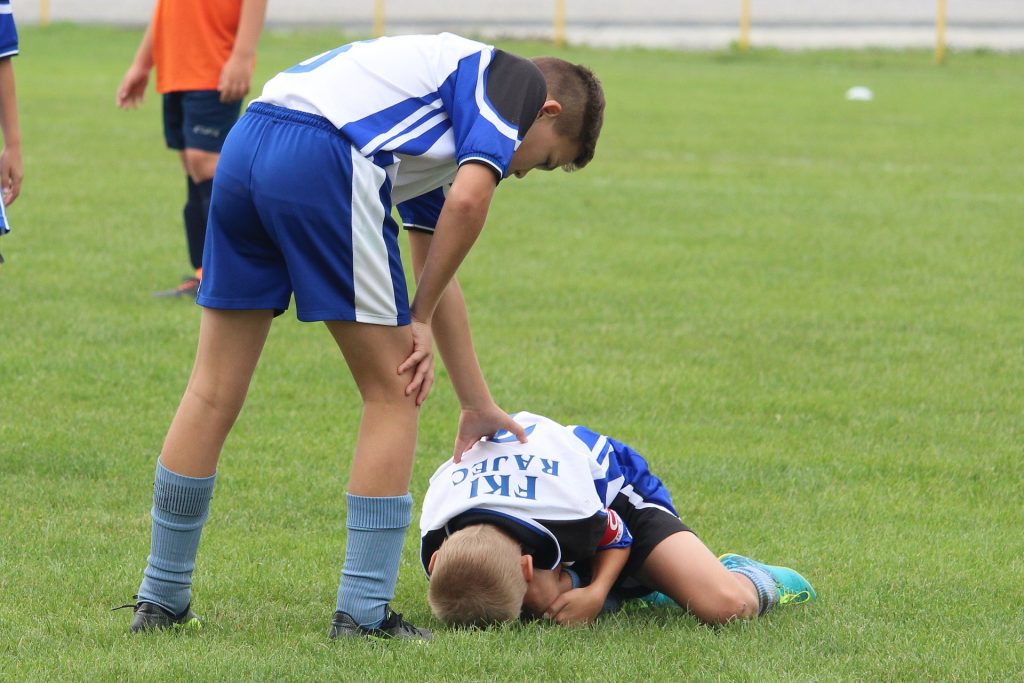During a soccer game, regular impacts and collisions between players create the possibility of injury. While the rules of the game provide safety measures, like requiring players to wear shin guards and not have iron studs on their cleats, there is still always a chance at injury. A player can become injured during a sprint, while kicking a ball, after a hard tackle, or even during goal celebrations. Below is a guideline on how to go about treating an injury sustained while playing:
- Common Soccer Injuries
- Identifying a Possible Injury
- Treatment Process for Minor Injuries
- When to See a Specialist
Common Soccer Injuries
A soccer player may sustain an injury in essentially every part of their body. The regions of the body where injuries could occur can be divided into three sections: the lower extremities, upper extremities and the head.
Injuries in the lower extremities affect the body parts from the toe to the hip. Examples of injuries occurring in this region include hip dislocation, groin injuries, hamstring strains, anterior cruciate ligament (ACL) tears (knee), achilles tendon rupture (calf), ankle sprains and breaks, and metatarsal fractures (bones in the feet). Bruises to the leg, kicks to shins and stepping on a player’s ankle may be classed as minor injuries, yet would still depend on the force applied to those areas.
In the upper extremities, soccer players may sustain different injuries such as a shoulder dislocation, back sprain and neck fracture. Though a minor injury, a painful impact to the finger could also be serious enough to keep a player out of a game or practice session.
Injuries to the head range from anything as mild to bumps, bruises, and cuts, to moderate or severe as concussions, deep cuts, fractured skull bones, and internal bleeding.
Identifying a Possible Injury

Observation is the first way to recognize whether a child is injured or not. A parent should reasonably examine how their child feels after a practice match or game, especially if the child ever stayed on the ground after a collision, showed signs of pain or exhaustion, or did not play to their usual standards.
A number of general questions can be asked:
- “How did you feel in the game today?”
- “Were you involved in any serious collisions?”
- “Do you feel pain in any of your joints (neck, shoulder, elbow, wrist, hip, knee, and ankle)?”
- “Did you feel any pain while running at any point during the game today?”
- “Did you hear any unusual sounds from your body while playing?”
- “Did you at any point during the game today clash heads with a teammate/opponent or fall and hit your head on the ground?”
Answers to these questions form an initial assessment and will help a parent know what type of injury may have occurred. These questions should be further refined in detail as the child as they may be reluctant to provide truthful answers, especially if there is an important game or tournament in the near future.
Treatment Process for Minor Injuries

Minor injuries can be taken care of by an individual or by parents, eliminating the immediate need to visit a doctor or see a specialist. When a child sustains a soft groin pain, twists an ankle, or muscles become sore, some steps can be taken within minutes to relieve pain and initiate the recovery process.
There are four steps to achieve relief for minor injuries, rest, ice, compression, and elevation. This four-step guide, known as RICE, is a first aid measure for addressing sprains, swelling, and bruises. When done appropriately, they can provide relief to the athlete between 15 minutes and 72 hours after the injury occurred. This process is relatively easy to understand and is straightforward to implement.
Rest: Rest is a useful first step in responding to minor injuries. If the body is in pain after any sort of impact, it is necessary for the player to either stop or take a break from playing. Following the practice or game, the player should rest as much as possible over the next two days. Attempting to play through an injury can make the situation worse and overall delay recovery time.
Ice: In the case of a sprain or some version of a painful collision, the player should apply a bag of ice to the affected part of the body. To produce optimal results, the ice wrap should last for 15 to 20 minutes at a time and be repeated over 3-hour intervals over a three day period. Icing an injury also helps to reduce swelling, however not all occasions call for the need to use ice. In fact, it should not be used if the swelling involves a nerve, if the athlete has cold hypersensitivity, or prior to any physical activity. Therefore, in conjunction with the cold treatment, introduction of heat to an injury may also prove to be beneficial. Applying warm temperatures to injuries can relieve pain and improve blood flow. It is most useful in warming up stiff or scarred soft tissues before stretching or exercise. These two methods of therapy can co-exist when you firstly apply ice, followed by the heat. For best results, each interval should not exceed 20 minutes.
Compression: Following an injury, ice should cover the impacted area by wrapping it with an elastic bandage or splint to prevent swelling. For adequate compression, the wrapping should not be too tough, as it may disrupt blood flow, and it should not be too loose. Keeping the wrapping snug will prove to have the best results.
Elevation: Elevating the injured area has been proven to reduce pain, swelling, and throbbing. To properly elevate, the injured area should be on an incline raised above the level of your heart. A convenient way to achieve elevation is to rest the injured body part on a pillow. This optimizes blood flow and enhances healing.
When to See a Specialist

Some injuries may look minor at first, but if certain symptoms persist, it will become necessary to visit a doctor or consult a specialist. Athletes should see a doctor when there is no relief after rest and home treatment and when the pain continues to affect training and performance. Head injuries, whether moderate or severe, will require immediate treatment. Should symptoms of a mild head injury last for more than two weeks, the athlete should also see a doctor. It is of utmost importance to listen to one’s body and prioritize their health following an injury.




